- Home
- About US
- Art and Craft
- Artisans
- Master Crafts Persons
- Supporting Institutions
- News and Events
- Schemes
- Contact us
- Contact
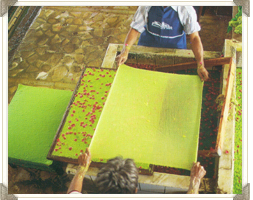
Paper Making in Rajasthan dates back to 1520s when mughal emperors encouraged this art and established a paper industry here. It was Maharaja Jai Singh II who bought this art to Jaipur and set up a paper business in Sanganer on the outskirts of the city. Today, the name of Sanganer has become synonym of the handmade paper.
The collection includes a variety of products. These acid free handmade papers can be put to multiple usages. Books with blank pages, portfolios, diaries, Stationary set, Photo frame, wrapping papers, Business cards, Letterheads, Envelops, Rough pad, Office Folder Pen Stand, Photo frame, Magazine stand, Coaster, Paper weight, Dustbins Briefcase, Telephone Index cum Diary, Handmade greeting cards, boxes of many different shapes and sizes, pencil boxes, sheets of paper and more. These items make great utility and great gifts. Paper shopping bags are another item much in demand. It is not only very useful, but also helps to reduce the use of poly bags.
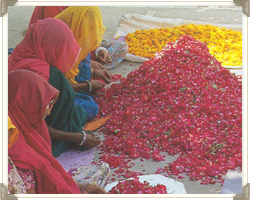
The process of making paper begins by reducing cotton waste to pulp. Flower petals and other accessories are added to the pulp which is then transferred to large tanks. Big trays of fine mesh are submerged into the water to take out the pulp from the bottom of the tank, which is then covered with a piece of muslin. The sheet of pulp is added to a pile. The pile is then pressed to drive out most of the water. The resulting sheets are peeled off the muslin and left to dry. The final result is handmade paper which is graceful with embedded various products. They may be further ornamented by different craft accessories.
Variety of accessories and creative minds have lead to a large number of handmade papers, which are not only exotic, but also make the products irresistible.
Paper with flower petals, silk paper, mulberry paper, banana paper, drawing paper, mottling paper, colored paper, batik paper, crinkle paper, textured paper, moon rock paper, embroidered paper, stitched paper, embossed papers, printed papers, batik paper are just few of them as the range sees no end. Zari, thread embroidery, hand block printing, embroidery printing, tie & dye, hand painting and other such patterns on these handmade papers add to their grace and charismatic look. The handmade paper can be put to any use and the paper products make perfect gifts.
Papermaking is the process of making paper, a material which is used universally today for writing and packaging.
In papermaking, a dilute suspension of fibres in water is drained through a screen, so that a mat of randomly interwoven fibres is laid down. Water is removed from this mat of fibres by pressing and drying to make paper. Since the invention of the Fourdrinier machine in the 19th century, most paper has been made from wood pulp because of cost. But other fibre sources such as cotton and textiles are used for high-quality papers. One common measure of a paper's quality is its non-wood-pulp content, e.g., 25% cotton, 50% rag, etc. Previously, paper was made up of rags and hemp as well as other materials.
These bags / shoppers are made of handmade paper of required thickness and strength. Paper carry bags hold much more weight as compared to plastic bags and are 100% bio-degradable and eco-friendly.
Different type of designs and printing are possible with paper carry bags. As you read this more and more organizations are moving towards this eco-friendly option, thus helping the nature preserve itself.
Almost any type of handmade paper can be used to make carry bags. Many designs are available in all standard and customized sizes.
Paper Making The process began by reducing cotton waste to pulp. the pulp is diluted with water and put into a masonry. The lifting mould (mesh on a wooden frame) is then dipped into the trough, shaken evenly and lifted out with the pulp on it. The consistency of the pulp in the tank should be kept constant Rose Plucking Roses are selected and plucked, Flower petals were added to the pulp which is then transferred to large tanks. workers submerged a rectangular tray of fine mesh into the water. Taking pulp from the tank, and emptied it into the tray.
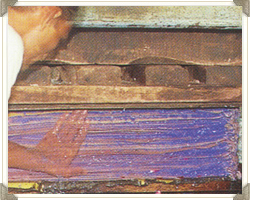
Pressing After inverting the tray and the muslin, the sheet of pulp now on top was added to a pile. The pile was then pressed to drive out most of the water. Pressing reduces the bulkiness of the paper i.e. the sheets become more compact.
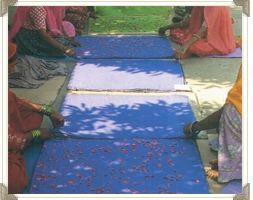
Separation Small dirt particles are removed manually with a sharp instrument. The cleaned sheets are given a coating with starch to improve the physical properties of the paper and prevent feathering. This is called sizing and can be done manually with a brush or by the dipping method.
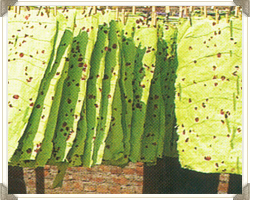
Natural Drying After Separation the resulting sheets were peeled off the muslin. As between 50 and 65% of moisture remains in the sheets. The sheets are dried by hanging them in open areas of sunlight to remove the rest of the moisture.
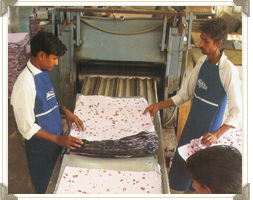
Calendaring Then Dried Paper is passed through a series of metal rolls at the end of a paper machine; when the paper is passed between these rolls it increases its smoothness and glossy surface.
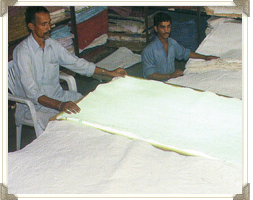
Inspection Calendared paper is hand- sorted, edges trimmed with the help of a hand- /power-operated cut- ting machine.
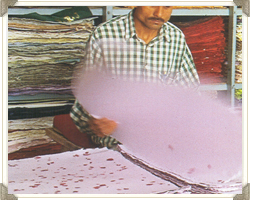
Sorting At this point the sheets are sort and cut to whatever sizes the customer desires. However, typically, the sheets are machine cut to a standard 22"x30" or 56x76 cm. size and then packed for shipment
Envelope Making Sheets are cut to appropriate sizes according to size of envelope being made and folded with a glue stick, to seal the three sides.
Screen Printing Screen printing uses silk or other fabric stretched tightly over a frame. Images are created by blocking parts of the screen with stencils created by hand-drawn or photographic techniques. Ink is forced through the open areas of the screen onto paper.
A wide range of raw materials, such as bamboo, wood grass, rice and wheat straw, jute, rags and waste paper are made available for paper and board making. The pulp and paper industry has recently experienced enormous growth, coupled with consolidation due to the value addition activities like embossing embroidery on handmade paper etc. Tucked away in a village near Jaipur is the world's largest centre of handmade paper. The handmade paper industry in India offers considerable potential to meet the increasing demand for paper products in an environmentally sound way. Delhi is an ideal location to find both of these materials because it has a thriving rag trade, which provides abundance of old cloth and vast amounts of used paper. Handmade paper production has low capital investment, thereby promoting local entrepreneurship, it generates more local employment; it is an environmentally sound technology, depleting less resources and causing less pollution than paper mill factories; and it can produce certain specialized varieties of paper, for example, watermark, filter paper and drawing sheets, etc. The cost difference between handmade paper and millmade paper is marginal. The concern about the disappearance of forests, coupled with renewed interest in the quality of papers generated new study of the paper maker's materials, especially the pulps and fibers. With several technological changes taking place in the paper industry, the government has to rethink its land use policies and conservation strategies to protect the natural resources.
Sanjhi is the name given to images of the Mother Goddess, which are made of cowdung paste and are molded into various shapes such as stars, moon, sun, or the face of the goddess, and they are given different colors. The local potters make images of various body parts like her arms, legs, face decked with ornaments and weapons. These additions make the image look beautiful and gracious. The additions to the image this way depend upon the economic means of the family.
The image is designed on the first day of the nine days of Durga Puja or navratras. Every day women from neighbourhood are invited for singing evening psalms and performing aarti. The young girls also gather there and offer their adoration to the mother who is believed to get them suitable husbands. the psalms or the bhajans are chanted daily and some elderly woman guides others. It is usually an all females event. Sanjhi image is prepared on the wall by those families who seek fulfillment of their wishes termed mannat bu Panjabis. some people also seek her blessings for the marriage of their daughters. Kirtan is performed and the image is immersed in water on the last day The Sanjhi festival ends with the immersion of Sanjhi on the day of Dussehra.
As a traditional art of Vraja, Lord Krishna’s homeland, sanjhi is intrinsically linked to the transcendental sports of the divine couple Krishna and Radha, whose play of love is depicted in the sanjhi designs. Vaishnava theology traces the origin of sanjhi to the divine lila itself: sanjhi designs were created by Radha in order to evoke Lord Krishna’s presence. Folk mythology also holds another version of the same lila, according to which it was Lord Krishna who, at evening twilight time, prepared a beautiful image of Radha made of flowers in order to appease her.
The early tradition of preparing sanjhis made of cowdung and flowers, which is still practiced in the villages, has been taken up by the Vaishnava temples
around the 15th/16th centuries and developed into a highly sophisticated art form practiced by specially trained Brahman priests.[5] The major type of temple sanjhi is prepared from dry colors upon an octagonal earthen platform symbolizing an eight-petalled lotus. The heart (hauda) of the design constitutes the seat of the divine couple, the sanctum sanctorum; from here, an intricate layout of artfully interlocked diagonal patterns enables the expansion of divinity towards the eight directions. The worship of a mystic design as in sanjhi is rooted in early Hinduism and Tantrism, and has obvious parallels in Vajrayana and Mahayana Buddhism. In both cases, song rendered in front of the design constitutes the central element of worship